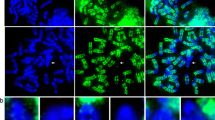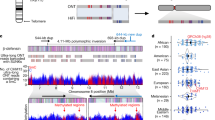Abstract
We have analysed the replication of the heterochromatic megachromosome that was formedde novo by a large-scale amplification process initiated in the centromeric region of mouse chromosome 7. The megachromosome is organized into amplicons ∼30 Mb in size, and each amplicon consists of two large inverted repeats delimited by a primary replication initiation site. Our results suggest that these segments represent a higher order replication unit (megareplicon) of the centromeric region of mouse chromosomes. Analysis of the replication of the megareplicons indicates that the pericentric heterochromatin and the centromere of mouse chromosomes begin to replicate early, and that their replication continues through approximately three-quarters of the S-phase. We suggest that a replication-directed mechanism may account for the initiation of large-scale amplification in the centromeric regions of mouse chromosomes, and may also explain the formation of new, stable chromosome segments and chromosomes.
Similar content being viewed by others
References
Brewer BJ, Fangman WL (1987) The localization of replication origins on ARS plasmids inS. cerevisiae.Cell 51: 463–471.
Bullock P, Botchan M (1982) Molecular events in the excision of SV40 DNA from the chromosomes of cultured mammalian cells. In: Schimke RT, ed.Gene Amplification. Cold Spring Harbor, NY: Cold Spring Harbor Laboratory Press, pp 215–224.
Burhans WC, Huberman JA (1994) DNA replication origins in animal cells — a question of context?Science 263: 639–640.
Burhans WC, Vassilev L, Caddle MS, Heitz NH, DePamphilis ML (1990) Identification of an origin of bi-directional DNA replication in mammalian chromosomes.Cell 62: 955–965.
Church K (1965) Replication of chromatin in mouse mammary epithelial cells grownin vitro.Genetics 52: 843–849.
Collins I, Newlon CS (1994) Chromosomal DNA replication initiates at the same origins in meiosis and mitosis.Mol Cell Biol 14: 3524–3534.
DePamphilis ML (1993) Eukaryotic DNA replication: anatomy of an origin.Annu Rev Biochem 62: 29–63.
Edenberg HJ, Huberman JA (1975) Eukaryotic chromosome replication.Annu Rev Genet 9: 245–284.
Fangman WL, Brewer BJ (1992) A question of time: replication origins of eukaryotic chromosomes.Cell 71: 363–366.
Haase SB, Heinzel SS, Calos MP (1994) Transcription inhibits the replication of autonomously replicating plasmids in human cells.Mol Cell Biol 14: 2516–2524.
Hadlaczky Gy, Praznovszky T, Cserpánet al. (1991) Centromere formation in mouse cells cotransformed with human DNA and a dominant marker gene.Proc Natl Acad Science USA 88: 8106–8110.
Handeli S, Klar A, Meuth M, Cedar H (1989) Mapping replication units in animal cells.Cell 57: 909–920.
Hassan BA, Errington RJ, White NS, Jackson DA, Cook PR (1994) Replication and transcription sites are colocalized in human cells.J Cell Sci 107: 425–434.
Hsu TC, Markvong A (1975) Chromosomes and DNA inMus: terminal DNA synthetic sequences in three species.Chromosoma 51: 311–322.
Huberman JA, Riggs AD (1968) On the mechanism of DNA replication in mammalian chromosomes.J Mol Biol 32: 327–341.
Huberman JA, Spotila LD, Nawotka KA, El-Assouli SM, Davis LR (1987) The in vivo replication origin of the yeast 2 μm plasmid.Cell 51: 473–481.
Hyrien O, Debatisse M, Buttin G, de Saint Vincent BR (1988) The multicopy appearance of large inverted duplication and the sequence at the inversion joint suggest a new model for gene amplification.EMBO J 7: 407–417.
Jacob F, Brenner S, Cuzin F (1963) On the regulation of DNA replication in bacteria.Cold Spring Harbor Symp Quant Biol 28: 329–348.
Kitsberg D, Selig S, Keshet I, Cedar H (1993) Replication structure of the human β-globin gene domain.Nature 366: 588–590.
Kornberg A, Baker TA (1992)DNA Replication, 2nd edn. New York: WH Freeman and Co., p. 474.
Looney JE, Ma C, Leu THet al. (1988) The dihydrofolate reductase amplicons in different methotrexate-resistant Chinese hamster cell lines share at least a 273-kilobase core sequence, but the amplicons in some cell lines are much larger and remarkably uniform in structure.Mol Cell Biol 8: 5268–5279.
Madan K, Allen JW, Gerald PS, Latt SA (1976) Fluorescence analysis of late DNA replication in mouse metaphase chromosomes using BUdR and 33258 Hoechst.Exp Cell Res 99: 438–444.
Miller OJ (1976) Is the centromeric heterochromatin inMus musculus late replicating?Chromosoma 55: 165–170.
O'Keefe RT, Henderson SC, Spector DL (1992) Dynamic organization of DNA replication in mammalian cell nuclei: Spatially and temporally defined replication of chromosome-specific α-satellite DNA sequences.J Cell Biol 116: 1095–1110.
Qastler H, Sherman FG (1959) Cell population kinetics in the intestinal epithelium of the mouse.Exp Cell Res 17: 420–438.
Selig S, Ariel M, Goitein R, Marcus M, Cedar H (1988) Regulation of mouse satellite DNA replication time.EMBO J 7: 419–426.
Smith KA, Gorman PA, Stark MB, Groves RP, Stark GR (1990) Distinctive chromosomal structures are formed very early in the amplification of CAD genes in Syrian hamster cells.Cell 63: 1219–1227.
Wintersberger E (1994) DNA amplification: New insights into its mechanism.Chromosoma 103: 73–81.
Author information
Authors and Affiliations
Corresponding author
Additional information
accepted for publication by H. C. Macgregor
Rights and permissions
About this article
Cite this article
Holló, G., Keresõ, J., Praznovszky, T. et al. Evidence for a megareplicon covering megabases of centromeric chromosome segments. Chromosome Res 4, 240–247 (1996). https://doi.org/10.1007/BF02254965
Received:
Revised:
Accepted:
Issue Date:
DOI: https://doi.org/10.1007/BF02254965




